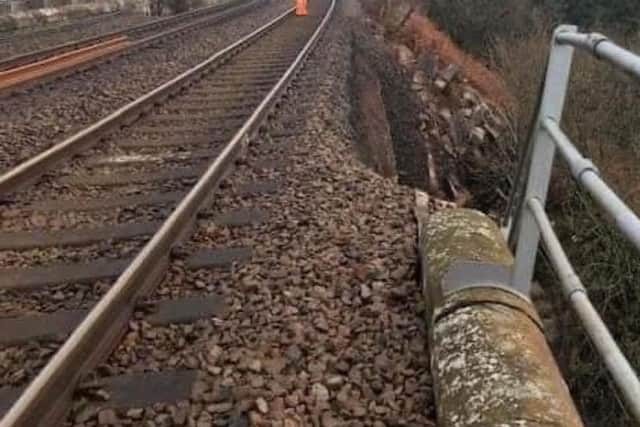Parapet collapse ‘may have been caused by weight of ballast’ as bridge repairs to take another three weeks


The theory came as Network Rail said repairs to the 180-year-old bridge – a mile from the fatal landslide collision site near Stonehaven – would take until February 22.
The line between Stonehaven and Montrose has been closed since January 15 when an 80ft long (24m) section of masonry fell from the bridge parapet or sidewall.
Advertisement
Hide AdAdvertisement
Hide AdIndustry commentator Philip Haigh, writing in RAIL magazine, he said: “Over the years, the track engineer had dropped more and more ballast to keep the track level.


"It might be that this increased burden of ballast has increased pressure on parapets not designed for such a load.
"To this should be added the effect of drainage.
"If the increased burden absorbs water, it increases its overall mass and thus the force on the parapets.
"In cold weather, it expands (or tries to), which again increases the force pushing the parapets outwards.
"There are doubtless other factors which Network Rail’s engineers will be investigating.
"My worry is that if my hypothesis is anything like right, then Network Rail might find itself with an awful lot of work to do to remove excess ballast from its masonry arch bridges.”
Rail engineer Gareth Dennis said if the ballast had increased, it could have been a contributory factor.
He told The Scotsman: “Photos and inspection reports show the ballast level was far above the level of the structural masonry.
Advertisement
Hide AdAdvertisement
Hide Ad"Ballast (the stones that support the track and hold it in place) gets dropped when the track position is corrected.
"The dropped stones are ‘tamped’ by a machine which corrects the overall level of the track to ensure a smooth ride.
"Over time, this means the track level rises, and on this bridge, with the track being on a curve, the ballast level is higher on the outside of the track.
"After three or four passes of this type of maintenance, the ballast is supposed to be renewed and the track level reset to its original position.
"If this hasn't happened here, then that could certainly be a contributing factor.
“What is more, when the speed was increased along this stretch of track some decades ago, this would have likely been achieved by lifting one rail higher above the other (a bit like a road tilting through curves), which would also result in more ballast being piled up against the parapet.”
A Network Rail spokesperson said: “We are carefully reviewing this incident, but it is too early to confirm the root cause of the parapet failure.
“Engineers will be working around-the-clock to fix the damaged parapet” and strengthen the bridge deck.
Advertisement
Hide AdAdvertisement
Hide Ad“To do this, engineers will first install additional concrete supports on the bridge deck to help retain and support the track and ballast.
“The parapet wall will then be reconstructed and ties installed on the bridge to further strengthen the masonry.
"Once those works are complete, the ballast and track will be relaid.
As The Scotsman revealed, the bridge was inspected in October and received a detailed examination in March 2018.
Network Rail said “no significant deterioration” of the structural condition was found.
It said additional inspections had been carried out “as a precaution” on similar bridges.
A message from the Editor:
Thank you for reading this article.
We're more reliant on your support than ever as the shift in consumer habits brought about by coronavirus impacts our advertisers.
If you haven't already, please consider supporting our trusted, fact-checked journalism by taking out a digital subscription.
Comments
Want to join the conversation? Please or to comment on this article.